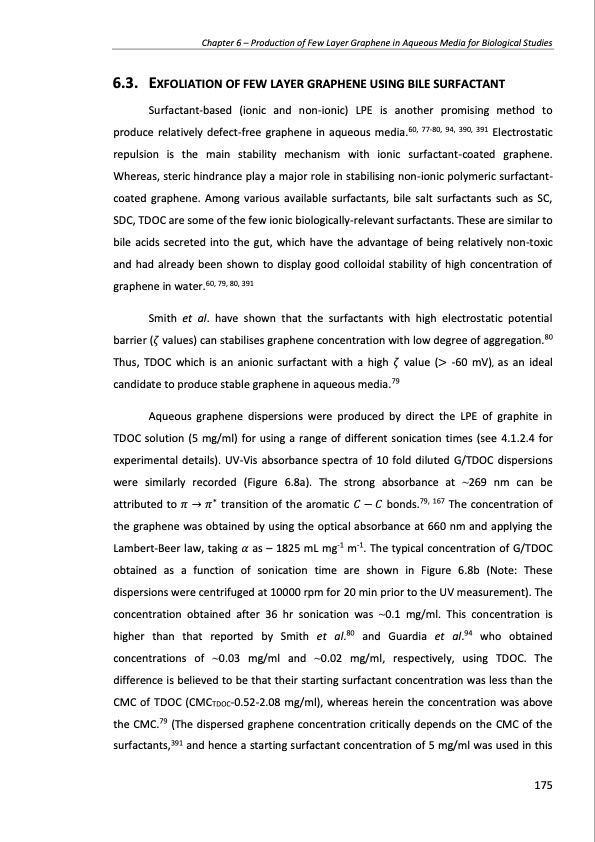PDF Publication Title:
Text from PDF Page: 175
Chapter 6 – Production of Few Layer Graphene in Aqueous Media for Biological Studies 6.3. EXFOLIATION OF FEW LAYER GRAPHENE USING BILE SURFACTANT Surfactant-based (ionic and non-ionic) LPE is another promising method to produce relatively defect-free graphene in aqueous media.60, 77-80, 94, 390, 391 Electrostatic repulsion is the main stability mechanism with ionic surfactant-coated graphene. Whereas, steric hindrance play a major role in stabilising non-ionic polymeric surfactant- coated graphene. Among various available surfactants, bile salt surfactants such as SC, SDC, TDOC are some of the few ionic biologically-relevant surfactants. These are similar to bile acids secreted into the gut, which have the advantage of being relatively non-toxic and had already been shown to display good colloidal stability of high concentration of graphene in water.60, 79, 80, 391 Smith et al. have shown that the surfactants with high electrostatic potential barrier (𝜁 values) can stabilises graphene concentration with low degree of aggregation.80 Thus, TDOC which is an anionic surfactant with a high 𝜁 value (> -60 mV), as an ideal candidate to produce stable graphene in aqueous media.79 Aqueous graphene dispersions were produced by direct the LPE of graphite in TDOC solution (5 mg/ml) for using a range of different sonication times (see 4.1.2.4 for experimental details). UV-Vis absorbance spectra of 10 fold diluted G/TDOC dispersions were similarly recorded (Figure 6.8a). The strong absorbance at ~269 nm can be attributed to 𝜋 → 𝜋∗ transition of the aromatic 𝐶 − 𝐶 bonds.79, 167 The concentration of the graphene was obtained by using the optical absorbance at 660 nm and applying the Lambert-Beer law, taking 𝛼 as – 1825 mL mg-1 m-1. The typical concentration of G/TDOC obtained as a function of sonication time are shown in Figure 6.8b (Note: These dispersions were centrifuged at 10000 rpm for 20 min prior to the UV measurement). The concentration obtained after 36 hr sonication was ~0.1 mg/ml. This concentration is higher than that reported by Smith et al.80 and Guardia et al.94 who obtained concentrations of ~0.03 mg/ml and ~0.02 mg/ml, respectively, using TDOC. The difference is believed to be that their starting surfactant concentration was less than the CMC of TDOC (CMCTDOC-0.52-2.08 mg/ml), whereas herein the concentration was above the CMC.79 (The dispersed graphene concentration critically depends on the CMC of the surfactants,391 and hence a starting surfactant concentration of 5 mg/ml was used in this 175PDF Image | PRODUCTION AND APPLICATIONS OF GRAPHENE AND ITS COMPOSITES

PDF Search Title:
PRODUCTION AND APPLICATIONS OF GRAPHENE AND ITS COMPOSITESOriginal File Name Searched:
graphene-production-applications.PDFDIY PDF Search: Google It | Yahoo | Bing
Salgenx Redox Flow Battery Technology: Power up your energy storage game with Salgenx Salt Water Battery. With its advanced technology, the flow battery provides reliable, scalable, and sustainable energy storage for utility-scale projects. Upgrade to a Salgenx flow battery today and take control of your energy future.
CONTACT TEL: 608-238-6001 Email: greg@infinityturbine.com (Standard Web Page)